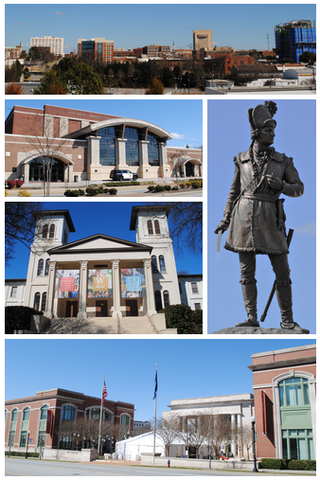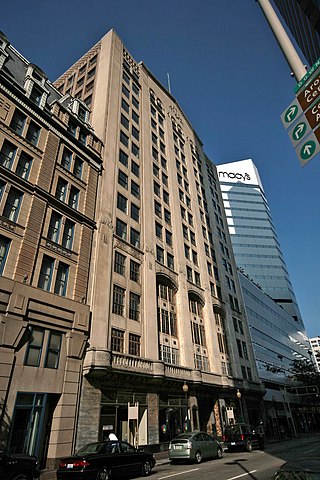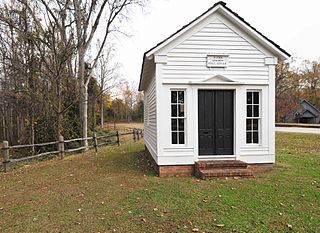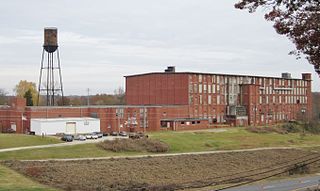
Spartanburg County is a county located on the northwestern border of the U.S. state of South Carolina. As of the 2020 census, the population was 327,997, making it the fifth-most populous county in South Carolina. Its county seat is Spartanburg. Spartanburg County is the largest county within the Spartanburg, SC Metropolitan Statistical Area, which is also included in the Greenville-Spartanburg-Anderson, SC Combined Statistical Area.

Gaffney is a city in and the seat of Cherokee County, South Carolina, United States, in the Upstate region of South Carolina. Gaffney is known as the "Peach Capital of South Carolina". The population was 12,539 at the 2010 census, with an estimated population of 12,609 in 2019. It is the principal city of the Gaffney, South Carolina, Micropolitan Statistical Area, which includes all of Cherokee County and which is further included in the greater Greenville-Spartanburg-Anderson, South Carolina Combined Statistical Area.

Pacolet is a town in Spartanburg County, South Carolina, United States. The population was 2,235 at the 2010 census.

Spartanburg is a city in and the seat of Spartanburg County, South Carolina, United States. The city had a population of 38,732 as of the 2020 census, making it the 11th-most populous city in the state. The Office of Management and Budget (OMB) groups Spartanburg and Union counties together as the Spartanburg, SC Metropolitan Statistical Area.

The Upstate, historically known as the Upcountry, is a region of the U.S. state of South Carolina, comprising the northwesternmost area of the state. Although loosely defined among locals, the general definition includes the 10 counties of the commerce-rich I-85 corridor in the northwest corner of South Carolina. This definition coincided with the Greenville-Spartanburg-Anderson, SC Combined Statistical Area, as first defined by the Office of Management and Budget (OMB) in 2015. In 2023, the OMB issued its most updated definition of the CSA that coincides again with the 10-county region.
Converse University is a private university in Spartanburg, South Carolina. It was established in 1889 by a group of Spartanburg residents and named after textile pioneer Dexter Edgar Converse. It was originally a women's college but now admits men.

Lockwood, Greene & Company was an American engineering firm. It was active under various names from 1871 to 2017.
Earle Sumner Draper was an American town planner and a landscape designer, who is known for coining the term "urban sprawl". He worked under John Nolen.

Arcadia Mills No. 2, now the Mayfair Lofts, is a historic mill building at 100 W. Cleveland St., Spartanburg, South Carolina. It was listed on the National Register of Historic Places in 2005.

Nuckolls-Jefferies House, also known as the Nuckolls House and Wagstop Plantation, is a historic plantation house located near Pacolet, Cherokee County, South Carolina. It was built in 1843, with alterations in the 1870s or 1880s. It is a 2+1⁄2-story, frame residence in a combined Greek Revival / Classical Revival style. It is clad in weatherboard and sits on a stone foundation. The front facade features a two-tiered central, pedimented portico supported by two sets of slender wooden posts. The rear of the house has a two-story ell, built during the 1996 restoration. Also on the property are three contributing outbuildings: a small, one-story log gable-front building that dates from the mid-to-late 19th century that served as the farm's smokehouse, a 1+1⁄2-story gable-front frame barn, and another frame gable-front barn with side shed lean-to extensions.
Pacolet Soapstone Quarries encompasses 13 historic archaeological sites located near Pacolet, Spartanburg County, South Carolina. It was the site of soapstone procurement activities during the Late Archaic Period for the purpose of creating vessels. The quarry sites are characterized by large outcropping boulders of soapstone surrounded by depressions and concentrations of soapstone debris.

Marysville School is a historic school building located near Pacolet, Spartanburg County, South Carolina. It built in 1915 by the Pacolet Manufacturing Company to serve the African-American community of Marystown. It is a 1 1/2-story, three room school building in an "L" shape. The school closed in 1954.

Pacolet Mill Office, also known as Pacolet Municipal Building and Town Hall, is a historic office building located at Pacolet, Spartanburg County, South Carolina. It built in 1908 by the Pacolet Manufacturing Company. It is a one-story, brick building with full-height basement level. It has a low-pitched hip roof with flared eaves and decorative exposed rafter tails. The roof is clad with clay Spanish tile. The site features a curving cast stone or concrete pergola added some time between 1920 and 1927. In 2004, the building became the town hall for the Town of Pacolet.

Pacolet Mills Cloth Room and Warehouse is a historic textile mill located at Pacolet, Spartanburg County, South Carolina. It was built in 1906–1907, and consists the 1 1/2-story, brick cloth building with the attached warehouse portion covered with weatherboard and metal. the building features a low-profiled roof and large rounded arch windows. The front portion of the building was used for inspecting cloth prior to shipping, and the rear portion was used as a warehouse.

Glenn Springs Historic District is a national historic district located at Glenn Springs, Spartanburg County, South Carolina. It encompasses 18 contributing buildings and 3 contributing sites in the historic health resort of Glenn Springs. The community developed as a resort around the mineral springs between about 1840 and 1940. The district includes several residences, two boarding houses, Cates House Ruins, Calvary Protestant Episcopal Church, Presbyterian Church, Cates Store, Glenn Springs Post Office, a pavilion, a cemetery, and the site of the Glenn Springs Hotel. It includes notable buildings in the Greek Revival, Gothic Revival, Queen Anne, and Bungalow styles.

Converse Heights Historic District is a national historic district located at Spartanburg, Spartanburg County, South Carolina. It encompasses 460 contributing buildings in a residential section of Spartanburg. The district documents the prevalent housing types for middle and upper class citizens from about 1900 to 1940. It includes residences representative of the Queen Anne, American Foursquare, American Craftsman, Spanish Mission, Tudor, Colonial Revival, and Neo-Classical styles.

Hurricane Tavern, also known as Workman Farm, is a national historic district located near Woodruff, Spartanburg County, South Carolina. The district encompasses 30 contributing buildings, 1 contributing site, and 1 contributing structure on a rural farmstead. They include the vernacular Federal style brick farmhouse, built about 1811, with major alterations and additions about 1850 and Bungalow modifications about 1920; a frame farmhouse, a country store, and a collection of late-19th and early-20th century agricultural outbuildings.

Drayton Mill is a historic textile mill complex located near Spartanburg, Spartanburg County, South Carolina. The complex includes the distinctive Tudor Revival company store and office building, constructed in 1919. Other buildings and structures include the three-story, rectangular, red brick spinning mill (1902-1904) with later additions, a cotton warehouse (1918), a two-story weaving building (1928), a 1,500,000 gallon mill pond, two water towers, two pump buildings, and an information center.

South Carolina Highway 150 (SC 150) is a 33.580-mile (54.042 km) primary state highway in the U.S. state of South Carolina. The highway connects Pacolet and Gaffney with the more rural areas of Spartanburg and Cherokee counties.

The Converse Mill, also known as Clifton Mill #3, is a historic textile mill at 200 High Street in Spartanburg, South Carolina. The main mill building is a four-story brick building with smaller additions, sited on 11 acres (4.5 ha) overlooking the Pacolet River to the east. The mill was built in 1903 on the site of Clifton Mill #3, then the largest textile mill in the world, which had been destroyed by flood. It was designed by the noted industrial architectural firm Lockwood, Green of Boston, Massachusetts. The mill was closed sometime between 1968 and 1973, after which many of its windows were bricked over and it was converted to a warehouse. It is the only surviving element of the Clifton Mill complex, which originally had three large buildings. It is currently being renovated into apartments, some of which have views of the Pacolet River.




















